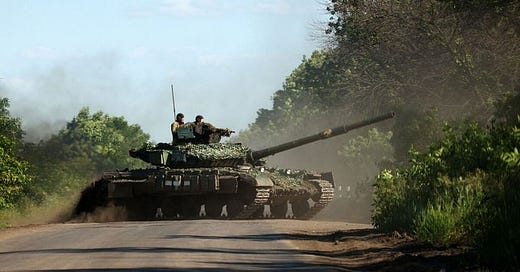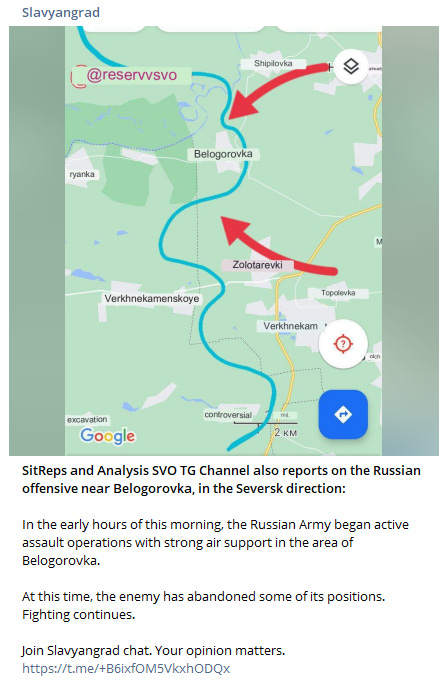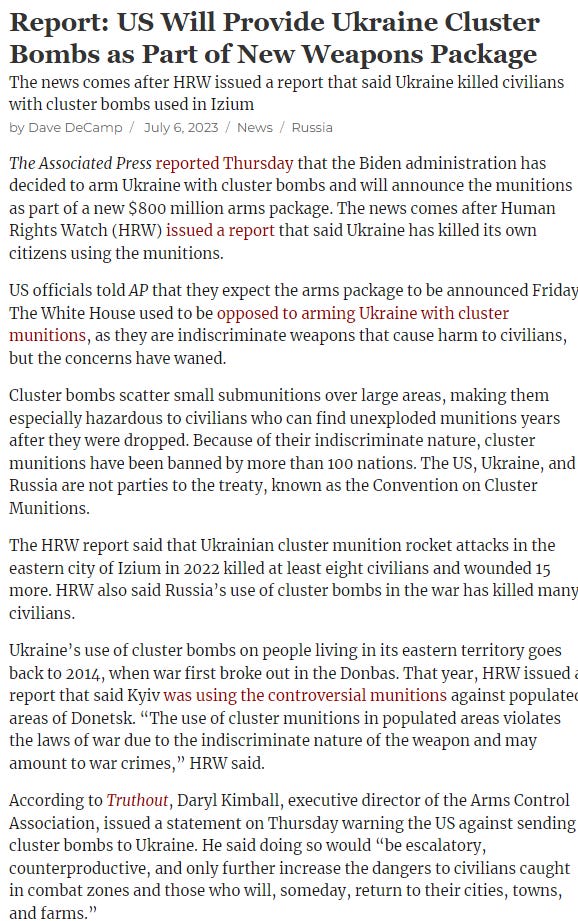On the territory of the military academy in Lvov, which was attacked at night by Russian missiles, there were Western armored vehicles. With a high degree of probability, British Challenger tanks were also there.
https://twitter.com/Trollstoy88/status/1677031540373565444
UKRAINIAN MOSQUITO TACTICS
Ukrainians are using new infantry-intensive tactics that their commanders developed with NATO, after 3 weeks of failed classical attacks that only led to mass loss of equipment, demoralisation and retreats.
Now they attack continuously using small tactical groups of infantry, knowing that Russians are much more averse to manpower losses.
As soon as close combat becomes imminent, Russians retreat and let artillery work on Ukrainian infantry sitting on the abandoned positions, which usually ends with Ukrainians suffering losses and fleeing.
However several such attacks can gradually push Russians to a new line, where the same meat assaults are repeated. This is how in 2 weeks Russians were pushed back 3 miles on the Vremevsky bridgehead.
NATO and Ukrainian commanders believe that in 2 weeks they will be able to overcome the Russian buffer zone and begin storming the main defense line.
On top of it, these tactics force Russian artillery to spend ammo stocks faster than they’re able to replenish them, and In just two weeks they may approach depletion.
Of course, these are meat tactics that lead to massive infantry looses, but it’s something Ukraine is willing to do - and it looks better to take losses for small advances than for no success at all as happened at the start of the offensive.
A Ukrainian assault group records its own destruction on the Svatovo-Kremennaya front, ending with the death of the cameraman.
Subscription is free
Repost
Highlights of Russian Military Operation in Ukraine on July 6
▪️Russian troops launched another massive strike on military facilities on the territory of Ukraine.
Critical infrastructure in Lviv, as well as AFU military equipment depots and bases were hit.
▪️In the Lyman area, the Ukrainian command continues to pull down manpower and armored vehicles to the front line.
Russian troops are striking at identified targets: a Swedish CV90 IFV was destroyed for the first time.
▪️On the Bakhmut section of the front, Russian units repulsed all enemy attacks near Berkhivka.
Amid the AFU retreat, the assault groups regained control of previously lost territories in the area of the reservoir.
▪️To the south, fierce fighting continues in the area of Klishchiivka.
Russian troops repulsed all attempts to occupy heights near the settlement and did not allow the enemy to break into the village.
▪️The AFU once again launched a massive strike on populated areas of the Donetsk agglomeration.
Infrastructure and residential buildings in Donetsk and Horlivka were damaged. One person was killed and at least six more were wounded.
▪️In the Zaporizhzhia direction, the AFU units do not stop undertaking sorties near the villages of Pyatykhatky and Zherebyanka.
The Russian troops confidently hold the defenses and promptly suppress all attempts to break through them.
▪️In Kherson region, the AFU continue shelling the front-line settlements on the left bank of the Dnipro River.
Every day the enemy fires dozens of shells, causing damage to residential buildings and civilian infrastructure.
#digest #Russia #Ukraine #video
https://t.me/militarysummary/2388
On Storm Shadow missile captured by Russians. What is interesting in it: analysis of the military chronicle.
The first Storm Shadow cruise missile was shot down over Ukraine, and during the fall all its key components and assemblies were preserved. Soon, all electronic equipment of the rocket and the hull will be delivered to Russia for study.
Who will study these wreckage?
In the structure of the Russian Ministry of Defense there is a GUV - the Main Directorate of Arms. They study all samples of promising weapons of a potential enemy, especially missile and aircraft. Most likely, first of all, the wreckage of Storm Shadow will fall into the 46th Central Research Institute of the Ministry of Defense. There, the body of the cruise missile will be scanned and tried to be restored, in order to then place the missile on a special rotary stand. On it, the military will study the reflective surface of Storm Shadow, after which it will be possible to understand how to more effectively detect and shoot down such missiles.
However, the path of the downed missile in Russia does not end there.
What is of interest?
In addition to the body of the rocket, which was relatively well preserved after it was blown up by an anti-aircraft missile, elements of the Storm Shadow engine survived. The rocket is equipped with a TRI 60-30 turbofan engine, the metals and alloys of which (both in the cold part - with fan blades, and in the hot part - at the exit of the jet stream) have been preserved. The engine control systems were not damaged (or were damaged minimally) in the fall of the rocket and are now of exceptional interest to Russian engine builders.
In addition, during the fall, the air intake system necessary for the operation of the engine, as well as the fuel system and pumps, survived, the study of the features of which will allow us to refine or revise the design of domestic cruise missiles, both existing and promising.
Of particular interest is the electronic filling: a flight control unit, a correction unit with satellite and inertial navigation, an infrared sensor for correcting target parameters before hitting, as well as sensors for separating the missile from the carrier aircraft.
Is the most important element of the rocket preserved?
When the missile was hit by the Russian air defense system, the leading cumulative charge of the BROACH (The Bomb Royal Ordnance Augmented Charge) combined warhead was also retained. Having studied its penetrating ability in relation to reinforced concrete, steel and ground coating, Russian experts will be able to conclude on the effectiveness of Storm Shadow against ground targets.
What is it for?
The study of the wreckage of a cruise missile will reveal the peculiarities of Western rocketry and will save Russian developers a lot of time on testing solutions in the field of tactical weapons. For example, by determining the shielding parameters of the GPS antenna, Russian specialists will be able to help the military-industrial complex increase the effectiveness of electronic warfare equipment to combat not only Storm Shadow missiles, but also the vast majority of cruise missiles created according to a similar design - French Scalp and German TAURUS, as well as American JASSM.
Of particular interest in studying the combat effectiveness of NATO cruise missiles is the control on-board computer, into which a flight mission is loaded. Reading Storm Shadow's memory will allow you to understand what combat scenarios the missile can perform, as well as which flight modes are normal for it, and which are critical.
https://t.me/CyberspecNews/35258
Dang mykola, let us see the entire column. French VAB and a Panthera T6 boinked
Another bunch of AFU guys decided to lay down their arms in the Kremennaya forests.
Don't think that they were beaten, they just jumped in different directions from the F1 grenades of our assault brigade and then decided that it was much better to surrender and live in peace.
#source (https://t.me/voenacher/47886)
Join Slavyangrad chat. Your opinion matters.
https://t.me/+B6ixfOM5VkxhODQx
Ukrainian channel Strana:
What are the cluster munitions that the US can transfer to Ukraine today? What will they change on the battlefield and why are human rights activists opposing them?
These are shells, rockets or bombs. They consist of containers that open in the air and scatter many small caliber bombs over a wide area.
The main purpose of these submunitions is to destroy multiple military targets. For example, infantry formations.
But there are many complaints about this weapon in the world - it carries increased threats to the civilian population and infrastructure.
As practice has shown, from 10% to 40% of submunitions do not explode. This leads to the fact that entire regions are flooded with tens of thousands, and sometimes millions of unexploded mini-bombs that can detonate at any moment.
This is a direct threat to civilians who are returning to their homes after the end of hostilities. In territories "sown" with cluster bombs, it is sometimes impossible to live and engage in agriculture for decades.
In this context, the Pentagon stated that they would transfer to Ukraine only those "cassettes" that showed a high percentage of operation during tests.
In addition, these charges pose a great threat to civilians and civilian infrastructure when used in populated areas.
Actually, therefore, international human rights activists urge the United States not to transfer these shells.
At the same time, military considerations are quite obvious, according to which the Ukrainian Armed Forces want to transfer cluster munitions. They will allow you to inflict serious damage on Russian troops. Especially those who are in a tight defense - as, for example, on the Zaporozhye front. And also in those areas where the Russians are trying to attack.
However, Russia also has large arsenals of cluster charges (and Ukraine has already accused the Russian Federation of using them). Considering that the Russians also repulse the attacks of the Armed Forces of Ukraine in the south mainly with artillery, the enemy may also begin to use "cassettes" more often.
Another effect of the supply of these weapons for the Armed Forces of Ukraine is the reduction of shell hunger. The Western Allies are running short of conventional 155mm munitions, reserves of which have already been spent on deliveries to Ukraine, and production has not kept up with the consumption of shells at the front. If the Americans "unpack" their stocks of "cassettes", then this will increase the overall supply of ammunition for the Armed Forces of Ukraine.
This plausible logic is confirmed by the fact that it is cluster-filled cannon shells that stand out - despite the fact that the United States has many other varieties of such ammunition - for example, bombs dropped from drones, which Ukraine requested back in March.
However, from the point of view of influencing the situation at the front, for cluster munitions (as well as for other types of supplied weapons), the fundamental point is the volume of deliveries. It depends on how often and everywhere the Ukrainian army will use this ammunition. Especially considering that the Russians, as mentioned above, also have "cassettes".
https://t.me/SLGmaps/35
Massacre on the left flank of the Zaporozhye front: our fighters trapped the enemy and destroyed an entire unit.
▪️ As a result of the failed offensive at Zherebianki, the enemy suffered heavy losses. During the repulsion of attacks in Vasilievsky District in the Kamensky direction, fighters of the 19th Division of the 58th Army of the Southern Military District destroyed the AFU by entire units.
▪️ For example, an assault group that attacked from the direction of Pyatikhatka ran into an "abandoned" trench, where it was completely destroyed, no fighters survived the blasts.
▪️ During the recent fighting, the enemy suffered substantial losses and began to retreat even from their forward positions in the lowlands.
#source (https://t.me/RVvoenkor/48851)
Join Slavyangrad chat. Your opinion matters.
https://t.me/+B6ixfOM5VkxhODQx
The MSM's Ukraine neo-Nazi Amnesia
As Russia invaded Ukraine, the entire MSM joined in lockstep to give us a narrative. An important part of the narrative was that Russia’s claim that Neo-Nazi’s are a force in Ukraine is a Kremlin lie. It is a narrative that is easily unraveled by the MSM’s own past articles. So far, no MSM outlets are willing to discuss this ugly truth today. Anyon…























Did the camera man shoot his own, sure did look like it.